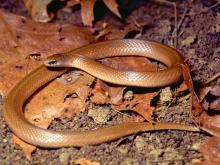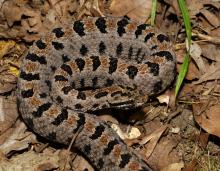Reptiles and Amphibians
Media

Species Types
Scientific Name
Ambystoma annulatum
Description
The ringed salamander is secretive, spending most of its time under logs or rocks or in burrows. The rings never completely encircle the body. It occurs in the southwestern and central Missouri Ozarks, and in the river hills of the Missouri River in eastern Missouri.
Media

Species Types
Scientific Name
Ambystoma maculatum
Description
The spotted salamander is one of Missouri's six species of mole salamanders. It is slate black with two irregular rows of rounded yellow spots from the head onto the tail. It occurs in forests in the southern two-thirds of the state.
Media

Species Types
Scientific Name
Lampropeltis calligaster
Description
The prairie kingsnake is fairly common over most of the state. The overall color is tan, brownish gray, or greenish gray. Numerous dark blotches down the back and sides are brown, reddish, or greenish brown. It lives in prairies, open woods, and rocky, wooded hillsides, statewide.
Media

Species Types
Scientific Name
Heterodon platirhinos
Description
The eastern hog-nosed snake is a nonvenomous snake that is highly variable in color and pattern. It has an upturned snout and can hiss loudly and spread its neck like a cobra. If this defense fails, the snake may thrash around, open its mouth, roll over, and play dead.
Media

Species Types
Scientific Name
Pantherophis emoryi
Description
The Great Plains ratsnake is seldom seen. It has numerous brown blotches along the body, a brown eye stripe, and a spearhead marking on top of the head.
Media

Species Types
Scientific Name
Virginia valeriae elegans
Description
The western smooth earthsnake is a small, plain, slightly stout snake. It is generally gray, brown, or reddish brown, with few distinct markings. It occurs statewide, except for the northwestern corner.
Media

Species Types
Scientific Name
Sistrurus miliarius streckeri
Description
The western pygmy rattlesnake is small and colorful, with a slender tail and tiny rattle. Its vibrating rattle is a faint buzz that sounds like a grasshopper. In Missouri, it occurs in the eastern Ozarks and in some counties bordering Arkansas.
Media

Species Types
Scientific Name
Agkistrodon contortrix
Description
The eastern copperhead is the most common venomous snake in Missouri. Its color varies from grayish brown to pinkish tan, with distinctive hourglass-shaped crossbands.
Media

Species Types
Scientific Name
Coluber constrictor flaviventris (eastern yellow-bellied racer) and Coluber constrictor priapus (southern black racer)
Description
The eastern yellow-bellied racer is uniformly tan, brown, olive, blue, gray, or nearly black on top, with a yellow, cream, or light blue-gray belly. It occurs nearly statewide. The southern black racer subspecies also lives in the southeastern half of the state.
Media

Species Types
Scientific Name
Thamnophis proximus proximus
Description
The orange-striped ribbonsnake is a type of gartersnake named for the attractive orange or yellow stripes running the length of its body, alternating with wide black stripes. It is found statewide, but seldom far from water.
See Also
About Reptiles and Amphibians in Missouri
Missouri’s herptiles comprise 43 amphibians and 75 reptiles. Amphibians, including salamanders, toads, and frogs, are vertebrate animals that spend at least part of their life cycle in water. They usually have moist skin, lack scales or claws, and are ectothermal (cold-blooded), so they do not produce their own body heat the way birds and mammals do. Reptiles, including turtles, lizards, and snakes, are also vertebrates, and most are ectothermal, but unlike amphibians, reptiles have dry skin with scales, the ones with legs have claws, and they do not have to live part of their lives in water.





















